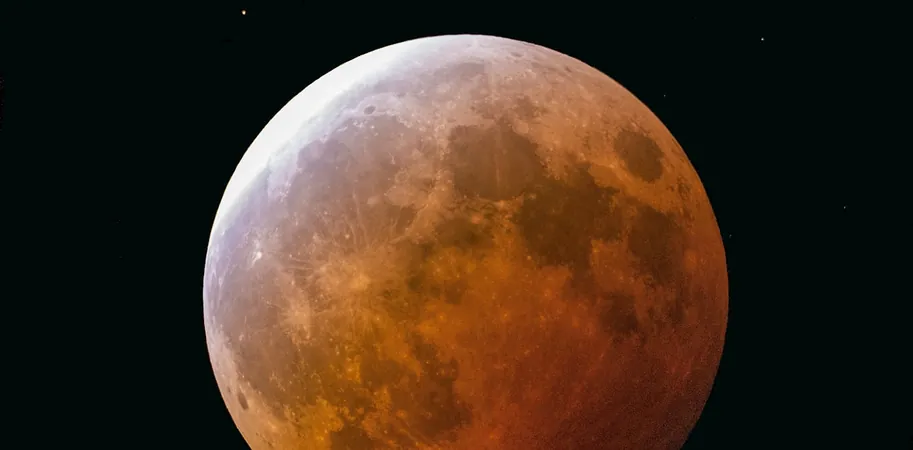
Total Lunar Eclipse, Mysterious Disappearance of Saturn's Rings, Meteor Showers and More: Your Ultimate Guide to the Southern Sky in 2025!
2024-12-31
Author: Arjun
2025 is shaping up to be a phenomenal year for stargazers around the globe, especially for those in the Southern Hemisphere.
Prepare for an awe-inspiring lineup of cosmic events that will turn your ordinary nights into extraordinary experiences.
Whether you're nestled in the tranquillity of a dark rural area or living amidst the bright lights of a city, you can witness these spectacular celestial phenomena without needing high-tech gear. Most of these events can be enjoyed with just your naked eye!
Mark Your Calendars for the Highlights!
**Lunar Eclipse: March & September**
The first lunar eclipse of the year will take place on the night of March 14, when a fully eclipsed Moon will grace the skies just after sunset, particularly for those in New Zealand. The spectacle will also be visible partially in eastern Australia.
But the real showstopper occurs on September 8 in the early morning hours, when the full Moon will be completely eclipsed, turning a mesmerizing red or copper color. This change in hue happens as Earth's shadow envelops the Moon, together with the refraction of sunlight through Earth's atmosphere—a phenomenon known as Rayleigh scattering.
For viewers along Australia's eastern coast, the eclipse will occur from 3:30 AM to 4:53 AM, while those in New Zealand will have a front-row seat from 5:30 AM until moonset.
**Saturn's Rings: Disappearing and Reappearing!**
Astrophiles will be thrilled by the rare occurrence of Saturn's rings appearing to vanish in early 2025. This phenomenon happens when Earth passes directly through the plane of Saturn's rings, which typically happens only twice during the planet's 29-year orbit. January to mid-February will provide stunning views of Saturn with its tilted rings, while March 24 will mark the date when they seem to "disappear." Don’t fret; telescopes at public observatories like Sydney Observatory and Melbourne Observatory make it easier to catch a glimpse of this stunning planet.
**Meteor Showers: May & December**
Don’t forget to look up on the mornings of May 7 and December 14-15 for the Eta Aquariids and Geminids meteor showers, respectively. Good news: 2025 corresponds to ideal conditions for viewing both, as the Moon will not overpower the meteors’ light. For the best experience, find a dark spot with less light pollution and direct your gaze toward the northeast for the Eta Aquariids and north for the Geminids!
**Planetary Parades: January, April & August**
The five naked-eye planets—Mercury, Venus, Mars, Jupiter, and Saturn—will trail across the heavens along the ecliptic plane, forming breathtaking alignments. Notable moments in 2025 include:
- **January 18-19:** Venus will dazzle near Saturn in the evening sky.
- **April 1-15:** A compact group of Mercury, Venus, and Saturn will grace the eastern skyline at dawn.
- **August 12-13:** Witness a rare close encounter between Venus and Jupiter in the morning sky!
**Constellations on Display: June & August**
As the year progresses, the Southern Cross (Crux) and Sagittarius will take center stage in the night sky. The Southern Cross, an iconic star formation, will be best placed for viewing in June, while Sagittarius, known for its teapot shape, will shine directly overhead in August.
These constellations are essential for amateur astronomers, providing direction to the heart of our galaxy, the Milky Way.
Prepare your stargazing gear and consider inviting friends and family to share in the wonder of these celestial events. The skies in 2025 are bound to be captivating, so don’t miss out on this cosmic adventure!

 Brasil (PT)
Brasil (PT)
 Canada (EN)
Canada (EN)
 Chile (ES)
Chile (ES)
 Česko (CS)
Česko (CS)
 대한민국 (KO)
대한민국 (KO)
 España (ES)
España (ES)
 France (FR)
France (FR)
 Hong Kong (EN)
Hong Kong (EN)
 Italia (IT)
Italia (IT)
 日本 (JA)
日本 (JA)
 Magyarország (HU)
Magyarország (HU)
 Norge (NO)
Norge (NO)
 Polska (PL)
Polska (PL)
 Schweiz (DE)
Schweiz (DE)
 Singapore (EN)
Singapore (EN)
 Sverige (SV)
Sverige (SV)
 Suomi (FI)
Suomi (FI)
 Türkiye (TR)
Türkiye (TR)
 الإمارات العربية المتحدة (AR)
الإمارات العربية المتحدة (AR)